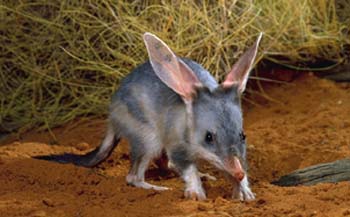

This order of marsupials includes 2 families, the Peramelidae (bandicoots and bilbies) and Peroryctidae (spiny bandicoots, mouse bandicoot).
Peramelemorphs are terrestrial animals of small to medium size. They have long pointed heads and compact bodies. Their forearms are short and and their hindlimbs relatively long. The forefeet of most species are adapted for digging, with long forefeet and strong claws on second, third, and fourth toes. The first and fifth toes are absent, or if present, small and lacking claws. On the hindfeet, the fourth toe is largest. Digits two and three are syndactylous, that is, they are joined except that they have separate claws. Peramelemorphs usually move by hopping. Characteristically, they land on hind and forefeet, and then take off with a push of their large hindfeet. An exception to this pattern was the pig-footed bandicoot, Chaeropus ecaudatus, which became extinct sometime after 1950. These animals had two functional toes on their forefeet and one on their hindfeet, each with hoof-like claws. They were said to have been agile and rapid runners, but little is known of their habits.
Peramelemorphs have 4-5 upper incisors and 3 lower incisors. They are considered to be among the polyprotodont marsupials, and the combination of syndactylous feet and polyprotodont incisors defines them. Their incisors are flattened at the tips, not pointed as they are in the other main group of polyprotodonts, the dasyuromorphs. The crown of the last lower incisor is bilobed. Peramelemorphs have well-developed canines, 3 upper and 3 lower premolars, and 4 upper and 4 lower molars. The third upper premolar is larger than the second. The premolars have a generally bladelike, slicing shape (plagialacoid), while the molars are tritubercular or quadrate.
The diet of bandicoots and bilbies is made up mostly of insects, but they also eat lots of plant material, and sometimes also rodents and lizards. Most species forage by rooting or digging about in the ground.
Older classifications divide the bilbies and bandicoots into two families, Thylacomyidae and Peramelidae, respectively. Recent molecular work has supported combining these two as a single family, the Peramelidae, but splitting out the spiny bandicoots and other New Guinea genera (Echymipera, Peroryctes, Microperoryctes) as a new family, the Peroryctidae.
An unusual feature of peramelemorphs is that they have chorioallantoic placentae. These differ from the chorioallantoic placentae of placentals, however, in that they have no villi, which effectively reduces the intimacy of contact between fetus and mother. A marsupium (pouch) is present and opens to the rear.
Peramelemorphs are found in a wide range of habitats in Australia and New Guinea.
Families of Peramelemorphia Family Peramelidae (bandicoots and bilbies) Family Peroryctidae (Spiny bandicoots)<<<<<<<>>>>>>> ARTIODACTYLA CARNIVORA CETACEA CHIROPTERA DASYUROMORPHIA DERMOPTERA DIDELPHIMORPHI DIPROTODONTIA HYRACOIDEA INSECTIVORA LAGOMORPHA MACROSCELIDEA MICROBIOTHERIA MONOTREMATA NOTORYCTEMORPHIA PAUCITUBERCULATA PERAMELEMORPHIA PERISSODACTYLA PHOLIDOTA PRIMATES PROBOSCIDEA RODENTIA SCANDENTIA SIRENIA TUBULIDENTATA XENARTHRA
Email: eradani7@aol.com